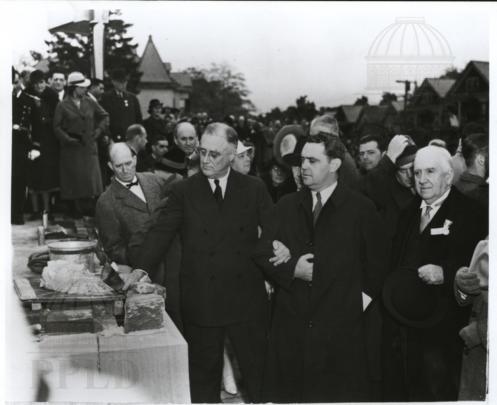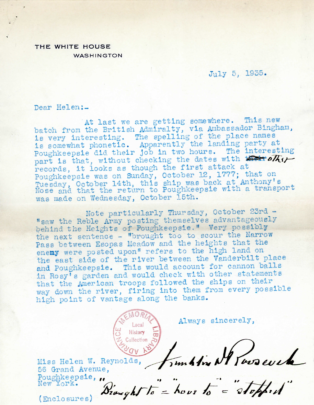by Shannon Butler
Franklin Delano Roosevelt was a true history nerd. Not only did he focus on the history of his family while studying at Harvard, but soon thereafter he was one of the creators of the Dutchess County Historical Society. By the 1920’s he was serving as the appointed historian of the Town of Hyde Park and collecting as many early records of the area as he could find. This passion for history carried into his most important role as the 32nd President of the United States. What’s interesting to note is that during his twelve years in office he still remained the town historian and even though he was President of the country, he was still only Vice President (one of many) of the Dutchess County Historical Society. We can see through a series of letters that one of the most powerful men in the world was still capable of geeking-out over historical facts that concerned his beloved Hyde Park.
Located in the Local History room here at Adriance Library is a box of letters from FDR to his friend and fellow history nerd, Helen Wilkinson Reynolds. Both had grown up in the Dutchess county area during the late 19th century (FDR at Hyde Park and HWR in Poughkeepsie). Both had been a part of the planning of the Dutchess County Historical Society. And finally, both loved to share the cool historical facts with one another. Even as President serving in the grips of the Great Depression, FDR never lost his passion for studying history and sharing what he had learned. There are several letters from him to Reynolds that discuss historical details on local subjects such as the Livingstons and their land and the Stoutenburgh family papers.
In 1935 FDR was clearly excited at the prospect of receiving documents from the British Admiralty concerning the movement of the British ships on the Hudson in 1777. FDR sent Reynolds a letter he wrote to Robert Bingham at the Embassy in London on June 11th asking him to get in touch with Admiral Dickens. He wanted him to find out if the detailed reports known as “Captain’s letters” could be located. He added “Tell him that one reason I am interested is not only on the account of the Dutchess County Historical Society, but also because a number of years ago we found some cannon ball in the ground of our place at Hyde Park.” It’s not likely that an average citizen would receive such information so speedily (but being President does have its perks).
By July 5th 1935, FDR shared with Helen the interesting discovery that the British were kind enough to quickly send over. We can see in the President’s letter how excited he was, “This new batch from the British Admiralty via Ambassador Bingham is very interesting.” He went on to describe how the British were firing at the rebels along the heights north of Poughkeepsie. “This would account for the cannon balls in Rosy’s garden” (James “Rosy” Roosevelt was FDR’s older half-brother and next door neighbor). Helen appears to have suggested that the new discovery should appear in the 1935 Dutchess County Historical Society Yearbook to which FDR enthusiastically replied, yes. The President even decided to take the time out of his busy schedule to write the article himself. It appeared in the yearbook with the following title,
“Events on Hudson’s River in 1777 as Recorded by British Officers in Contemporary Reports: The said reports are on file in the British Admiralty and copies of them have been deposited with the Dutchess County Historical Society by the President of the United States”
We can see from this lengthy title that FDR was proud of his achievement and splendid contribution to local history. He continued to collect documents and artifacts throughout his Presidency, even researching and writing articles like the true historian he was.
Remember, you can find more of the Roosevelt-Reynolds Correspondence and other cool history nerd things in the Local History Room at the Adriance Memorial Library. Please feel free to email us localhistory@poklib.org for more information.



